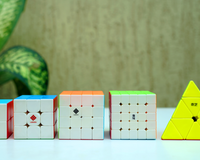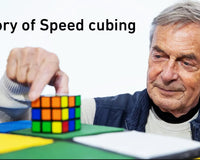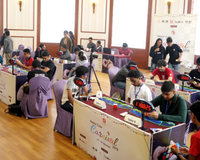Introduction
Solving a Rubik’s Cube is always a good way to show off to your friends, but what about solving it blindfolded? It sounds like magic, but it isn’t. There’s actually an official WCA event dedicated to blindfolded solving called 3BLD. This blog will show you that it’s possible to solve a cube without looking at it and how even YOU can learn to do so!
Yes, It’s Possible!
It is a 100% possible to solve a Rubik’s Cube blindfolded. Cubers also compete internationally to solve it the fastest, while blindfolded!
Fun fact, the world record for solving a cube blindfolded is exactly 12 seconds (as of 2025), which includes both memorization and execution.
It does sound crazy, doesn’t it! Let’s break it down.

The Two-Part Process: Memorization and Execution
A blindfolded solve is split into two parts:
1. Memorization Phase
Unlike a normal 3x3 solve which has 15 seconds of inspection, the competitors in a 3x3 blindfolded solve are allowed to inspect the scrambled cube for as long as they want before putting on the blindfold.
But the catch is: The timer is running during the inspection phase as well, and the final registered time of solving includes both the memorization phase and the solving phase! During the memorization phase, competitors take a note of where each piece is and form a memory sequence piece by piece that tells them how to restore all the pieces back to their solved state.
This is done using letter-pair mnemonics or visualization techniques. Each sticker on the cube is assigned a letter, and competitors memorize the target positions of the pieces as a sequence of letters.
For example, if a particular edge is currently at position A but it actually belongs to position B, the solver will remember that transition (AB) and so on for all unsolved pieces.
2. Execution Phase

Once the blindfold goes on, it’s all about remembering the letter sequences and being careful with algorithms, because a single accidental move can ruin the whole solve! The most commonly used method for blindfolded solving is called “Old Pochmann”, in which a buffer edge slot is used to move all the edges to their corresponding spots, and a buffer corner slot is used to do the same for the corners.
For example: A buffer slot contains an edge that goes to position X, meaning the edge that was previously in position X now comes to the buffer slot, this new edge needs to go to position M (for example), so the edge that was previously in position M now comes to the buffer slot, and so on. This creates a sequence X, then M, and so on, with the final sequence having around 12-14 letters on average depending on the scramble. The same process is repeated for corners.
Why It’s So Difficult: The Real Challenges
1. You Can’t Make a Single Mistake
There’s no visual input for you, one wrong turn, one slip-up, one wrong memory and the whole solve can fall apart. You can’t “see and fix” anything.
2. It’s Mentally Engaging
Even a regular 3x3 has 20 moving pieces (8 corners + 12 edges). That means solvers have to memorize the exact location of each of these pieces and also the order in which to solve them. This uses a lot of working memory, spatial awareness, and concentration.
Most solvers use their own memory techniques and tricks to make the letter sequences easier to remember. For example, “ERN” can be memorized by just remembering the phrase “Earn without A” and “GDS” can be memorized by remembering the phrase “Great Dane Service”.
3. Pressure Makes It Harder
In normal 3x3 speedsolving, you can recover from a few fumbles, but blindfolded cubing doesn’t work that way. Either you solve it or you don’t. And in competitions, you only get a few attempts. That makes the pressure intense even for experienced solvers.
Not Just 3x3 — Bigger Blindfolded Solves Exist!

Once you master 3BLD, you can even go for harder events. The WCA also has 4x4 and 5x5 blindfolded events (called 4BLD and 5BLD), which are way harder. There’s also a Multi-Blind event, where competitors solve multiple cubes blindfolded in a row, using just one look for all of them. The current world record for multi-blind is held by Rowe Hessler, who solved 63 cubes out of 66, while blindfolded in under one hour, including memorization!
Yes, really.
Should You Try It?
If you’re already comfortable or bored with 3x3 and are looking to try something new, blindfolded solving is an amazing skill to learn. It is beneficial for your focus, memory and patience. Plus, it’s one of the most impressive cubing tricks to show off!
Start with learning basic blindfold methods like Old Pochmann, and spend some time practicing these methods without a blindfold. There are lots and lots of YouTube tutorials that can help you with learning blindfolded solving!
































